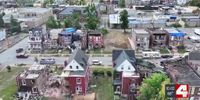As the calendar turns to late September 2025, communities across the United States are still grappling with the aftermath of a series of devastating tornadoes that struck over the past year. From the quiet neighborhoods of Stuart, Florida, to the bustling city streets of St. Louis, Missouri, the rural expanse of Laurel County, Kentucky, and the resilient businesses of Rocky Mount, North Carolina, stories of destruction, recovery, and hope are woven together by a common thread: the unwavering spirit of those determined to rebuild.
In Stuart, Florida, the scars of October 2024’s tornado are still visible, but so too are the signs of recovery. On SE Palmetto Road, a modest 426-square-foot tiny home stands ready for occupancy, a beacon of hope for Diana Dotson. Dotson, a great-grandmother who lived in her home for 48 years before it was heavily damaged by the tornado, is preparing to move into the tiny house—her own space once again after months of living with her daughter in Port St. Lucie. “I think it will be a blessing for me to be there. I thank God for Project Lift and the ones that’s helping me to get in there. Everyone. I really appreciate it,” Dotson told CBS12, expressing gratitude for the support she’s received.
This tiny home, along with another, was built by Project Lift, a Hobe Sound-based nonprofit that provides mental health counseling and job training in skilled trades to young people aged 14-25. Each home cost about $63,000 to construct. The project was conceived as a practical solution for residents like Dotson, whose homes were rendered uninhabitable by the storm. By placing the tiny homes in the victims’ front yards, Project Lift enabled them to remain close to their property, meet with insurance representatives, and oversee repairs. The process wasn’t without its challenges. Although Dotson’s tiny home arrived in December 2024, it took several months to complete the necessary permits and utility connections. Now, as she prepares to move in, she looks forward to a sense of independence and comfort during her home’s extensive repairs. “To be able to have my own space, there’s nothing like having your own space. Not that I’m not grateful for my children, which I am very highly grateful. But I’d rather have my own space,” she said.
Elsewhere in the neighborhood, the signs of ongoing recovery are evident. Some homes remain boarded up, while others sport blue tarps on their roofs. Rev. Glenford Hutchinson, a retired pastor, lost his roof in the same tornado. After six months of frustrating back-and-forth with his insurance company, he finally has a new roof as of September 2025. “Yes it became a little frustrating sometimes, back and forth with the insurance company,” Hutchinson admitted to CBS12. Despite the challenges, he’s optimistic about the progress made in the community.
Hundreds of miles to the northwest, St. Louis, Missouri, is also working to provide stable housing for tornado victims. The city is deploying $2.5 million in Rams Settlement funds to renovate vacant rental properties for those displaced by the tornado that struck on May 16, 2025. The City of St. Louis Community Development Administration (CDA) opened applications on September 26, 2025, for grants to repair vacant units. Each unit could receive up to $10,000 for essential repairs—think paint, plumbing, and electrical work. The goal is clear: get tornado-impacted families into safe, affordable housing before the winter chill sets in.
Tom Nagel, spokesperson for the CDA, explained to First Alert 4, “The Community Development Administration, our role in the City of St. Louis, is to fund the creation of affordable housing. We have thousands of units under construction that we are subsidizing. Part of our role in the rebuilding, in the recovery, is this notice of funding availability, grant funding to take vacant units and whatever repairs they need, maybe it’s paint and patching, maybe it’s plumbing and electrical.”
Importantly, the funding is limited to nonprofit developers, Community Development Corporations, and public entities—excluding for-profit landlords for now. Linda Nguyen, representing the Community Builders Network, highlighted the scale of opportunity: “A lot of affordable housing developers, non-profit affordable housing developers, have hundreds of vacant units at this time available and with a quick strategic investment, these units can be really quick to turn over and be available before winter starts.” The deadline for applications is October 31, 2025, and the city aims to have families moved in by year’s end. Disaster case management agencies are on hand to help coordinate housing for those in need.
In rural Laurel County, Kentucky, the London Corbin Airport is a symbol of both loss and resilience following the May 2025 tornado. The storm destroyed 21 aircraft, eight hangars, and scattered debris across the taxiway. Yet, the response from the community was immediate and overwhelming. Flight instructor Michael Carroll recounted to LEX 18 how he cut his honeymoon short to help with cleanup efforts. “Seeing it on live streams that a tornado was ripping through town. It was pretty, pretty gut wrenching,” he recalled. Airport Manager Matt Singer described the communal effort: “There’s people just showed up and helped started just, you didn’t even tell them where to go to start clean up. That was the craziest thing to me.”
Despite the massive operational challenge, the airport reopened for aircraft operations within days of the disaster. The initial shock, Singer said, gave way to a sense of opportunity. “It’s kind of giving us a magic eraser. You know, it’s bad to say, but at the same time it’s an opportunity.” The airport is now planning to widen taxiways to accommodate larger aircraft, a move that will improve functionality for years to come. Carroll found hope in the rebuilding process: “It gives you hope for the future.”
In Rocky Mount, North Carolina, the aftermath of an EF3 tornado that struck a year ago still lingers. Keishia Justice, a local business owner, watched her business crumble in the storm, but as of September 26, 2025, she’s back on her feet. According to WRAL, Nash County officials are urging residents to prepare for another potential storm, a reminder that recovery is an ongoing process. The community’s determination has helped residents and businesses get back on their feet, underscoring the importance of preparedness and resilience.
Across these diverse communities, the journey from devastation to recovery is marked by grit, collaboration, and innovation. Whether it’s a tiny home in a Florida front yard, a rehabbed apartment in St. Louis, a revitalized airport in Kentucky, or a rebuilt business in North Carolina, the message is clear: even in the face of disaster, hope and hard work can pave the way forward.





